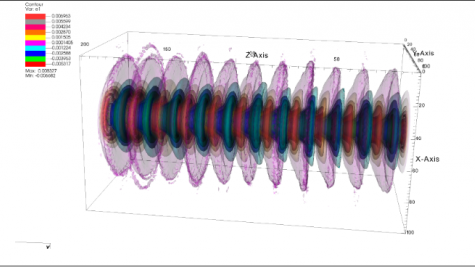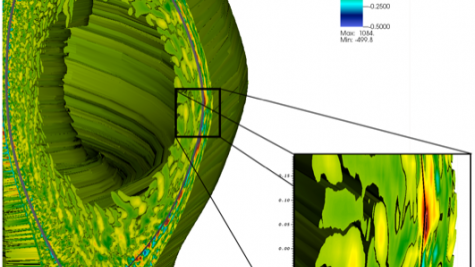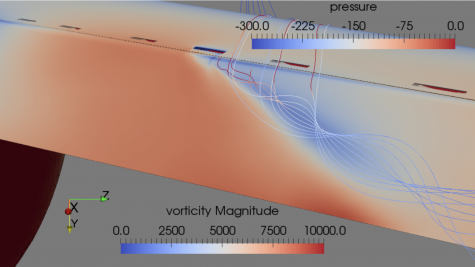ALCF projects cover many scientific disciplines, ranging from biology and physics to materials science and energy technologies. Filter ongoing and past projects by allocation program, scientific domain, and year.
Petascale Simulations of Kinetic Effects in IFE Plasmas
This project seeks study laser plasma interactions on meaningful spatial and temporal scales of relevance to various inertial fusion energy scenarios.
High-Fidelity Gyrokinetic Simulation of Tokamak and ITER Edge Physics
This project uses the gyrokinetic particle-in-cell code XGC to study fundamental edge physics issues critical to the success of ITER and the magnetic fusion energy programs.
Adaptive DDES of a Vertical Tail/Rudder Assembly with Active Flow Control
This project combines a highly scalable computational fluid dynamics solver with anisotropically adapted unstructured grids to enable flow simulations of unprecedented scale and complexity on Theta, gaining insight into questions of 3D active flow control.
Toward the Future: High-Fidelity Simulation for Next-Generation Nuclear Reactors
The team will use Theta to carry out simulations aimed at advancing the design of next-generation nuclear reactors. Their project will perform high-fidelity calculations of the flow and heat transfer behavior for pebble bed, gas-cooled reactors and force fluctuation in a fuel assembly with spacer grids.
Plasma Surface Interaction Modeling
This project will advance fusion energy research by performing large-scale simulations to shed light on plasma surface interactions. The team will use Theta to study the response of tungsten, the proposed ITER divertor, to low-energy, mixed H-He plasma exposure in the presence of impurity atoms.
Reconstructing Neutrino Data with the MicroBooNE Liquid Argon Detector
Researchers will use Theta to reconstruct the full dataset of neutrinos from the NuMI neutrino beam using the MicroBooNE detector at Fermilab, and to perform high-precision measurements of the electron-neutrino cross-section on argon and the KDAR muon neutrino cross-section. Their project will also aid in the search for exotic particles beyond the standard model using the five years of data acquired by the MicroBooNE detector.
Understanding the Role of Hierarchical Correlations in Solution-Phase Chemical Separations
With this project, researchers will perform large-scale molecular-dynamics (MD) simulations to advance our understanding of chemical separations. Their simulations will provide critical input to ongoing machine learning studies and provide insights to understand experimental results through modeling.
Predictive Modeling of Nanoporous Materials and Multiphase Systems
This project will use predictive hierarchical modeling and machine learning to accelerate the discovery and design of materials for a variety of energy-related applications. Their work will improve the understanding and selection of nanoporous materials for separation and catalytic processes in the chemical, biorenewable, and petrochemical industries.
Supercomputing for Automotive High-Temperature Alloy Design
This project aims to support the modern design of high-temperature alloys for automotive propulsion applications. The team's research will fill key knowledge gaps and reduce the time required to move from prototype high-temperature alloy development concepts to real-world deployment.
Optimization Studies of the LBNF - PIP-II Complex for Megawatt Beams on Target
This project will use DOE supercomputers to develop a detailed model of Fermilab's Proton Improvement Plan (PIP-II) facility's accelerator beamline and infrastructure. Their work will enable comprehensive Monte Carlo studies from the standpoint of radiation shielding including both normal operation and accident scenarios.
DNS Simulations of Coolant Flow in the High-Flux Isotope Reactor
This ALCC project will support an effort underway to investigate the conversion of the High Flux Isotope Reactor from a high enriched uranium core to a low enriched uranium core. The team will perform direct numerical simulations of turbulent single- and two-phase flows at an unprecedented level of detail to answer fundamental questions about the interaction and evolution of turbulence within complex geometries.
Chiral Nuclear Interactions from Nuclei to Nucleonic Matter
The team will provide a comprehensive study of the model-dependence of the equation of state of neutron matter, particularly relevant in view of the recent detection of gravitational waves by the LIGO-Virgo collaboration.
Automatic Building Energy Modeling
With this ALCC project, researchers will use DOE supercomputers to leverage existing organizational relationships, scalable data sources, and unique algorithms to develop nation-scale building energy use models.
High-Temperature Material Properties from First Principles
This project aims to demonstrate, for the first time, the viability of assessing the long-term properties necessary for the design of new, high-temperature energy generation technologies. To do so, the researchers will carry out a large grid of molecular dynamics calculations spanning several orders of magnitude in strain rate and initial defect density.
Many-Body Perturbation Theory Meets Machine Learning to Discover Materials for Organic Photovoltaics
This project seeks to accelerate the discovery and deployment of new solar materials for better organic solar cells by combining quantum mechanical simulations with machine learning.
Nucleon Axial Charge with All-Staggered Lattice QCD
This project will take the next step in demonstrating that staggered valence quarks are a viable strategy in lattice quantum chromodynamics (QCD) for nucleon physics. With this ALCC allocation, the team will compute the nucleon axial charge, a hadronic matrix element entering the neutron decay rate and, simultaneously, the normalization of the nucleon axial form factor.
Stochastic A Priori Dynamics for Complex Reactive Chemical Environments
This project will apply a theoretical framework for predicting the chemistry of complex systems, in both the gas phase and extended phases, that is readily parallelizable and scalable and that leverages high-performance computing. The resulting stochastic a priori dynamics approach is designed to enable predictive discovery in systems with use-inspired complexities.
Interpretable Machine Learning Force Fields for Accurate Chemical Reactive Dynamics
Researchers will use DOE supercomputers to generate a database of quantum-mechanical data for ground and excited electronic states of gas-phase chemical intermediates. Data will subsequently be used to train a deep neural network reactive force field capable of accurately describing chemical reaction dynamics.
Benchmarking Many-Body Perturbation Theory
This project will use newly implemented multi-reference quantum Monte Carlo (QMC) methods to provide reference data for parallelized many-body perturbation theory calculations of several molecular sets and explore approaches to improve their accuracy.
Distributed Large Wavefield Propagation and 3D Reconstruction Beyond the Depth of Focus Limit
Researchers will continue their work to develop novel algorithms for reconstructing x-ray images of thick, real-life materials. Their approach aims to advance the full range of future nanoscale imaging activities, including cell and brain imaging research, at Argonne's Advanced Photon Source and other DOE light sources.


